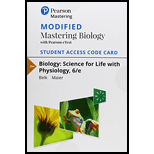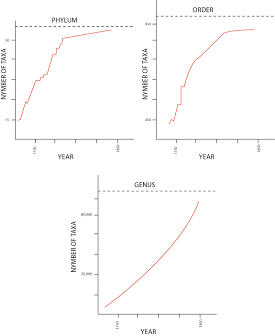
Concept explainers
How many different species have been identified by science? How many are estimated to exist?
To write:
About the estimation of species that have been described by science.
Introduction:
On Earth, a characteristic of life is that it is full of variety. Experts refer that the variation among and within living species is known as biodiversity. These studies not only provide interesting stories and fodder for arguments about the “best species”, but they also help us to understand the evolutionary origins of different groups of organisms and their function in biological systems. Systematists are scientists specializing in the description and categorization of a specific group of organisms.
Explanation of Solution
In central databases, 1.5 million identified species were described. The new estimation of total species on Earth is around 8.7 million i.e., on land 6.5 million species are present and in oceans 2.2 million. 20% of the total is known to science at the moment. Scientists use extrapolation to determine how many species are yet to be discovered. Thegraphs below showed the number of new groups of animals within each taxonomic level (taxa) over time. In the graph, leveling off showed that few new groups are probably left to discover. The dotted lines that showed on each group will level off, based on the historical pattern.

Till date, around 1.5 million species are identified.
Want to see more full solutions like this?
Chapter 14 Solutions
EP BIOLOGY:SCIENCE F/LIFE...-MOD.ACCESS
Additional Science Textbook Solutions
Chemistry
Biological Science (6th Edition)
Genetics: From Genes to Genomes
Campbell Biology in Focus (2nd Edition)
Campbell Essential Biology (7th Edition)
- 1) How have scientists created the "tree of life"? Do you think that variations exist between these created trees? 2) What are the pros and cons to creating a "tree of life"? 3) When constructing this tree of life we can see many dead ends or organisms that we are unsure of their exact placement. Why is this? 4) Choose one species (either alive today or extinct) and describe its taxonomic classification. What traits or characteristics were used to classify this species into its current taxonomic classification? What other organisms are considered to be its closest relatives?arrow_forwardExplain your answer in some depth and avoid just saying "It is A" or It is B. Defend your answer and explain why you choice that answer choice. Question: Domestic dogs would least likely meet the definition of a single species using which concept? Group of answer choices A) Lineage B) Biological C) Morphological D) Domestic dogs are not a single species according to any of the species concept definitions.arrow_forwardWhy All Species Are Unique?arrow_forward
- Closely related species are grouped together into (singular, ). By the way, what is the singular of “species”?arrow_forward12) Instead of 1 uniform definition, biologist use over 20 different definitions of "species". Why? A) Because scientists searching for life on other planets do not want to be restricted to the narrow definition that applies to earth based life forms B) Because historically biologist have argued over the correct definition of this term and therefore have split into seperate "camps" for different definitions C) Because life includes both sexual and asexually reproducing organisms D) Because life is so diverse that no single definition used so far can be uniformly applied in a meaningful way to all organismsarrow_forwardHow are millions of organisms on earth classified by scientists?arrow_forward
- What is a species? What types of observations do researchersanalyze when trying to identify species?arrow_forwardUse the DNA-DNA hybridization data from species A, B, C, D, and E showing the % difference in DNA between each species to answer the question that follows: D E C Species B A 4 3 3 2 X 4 3 3 B X 2 4 1 C 3 X 3 4 X D 3 1 3 X 4 E 4 4 4 23. Which of the following phylogenetic trees correctly illustrates the relationships between species A, B, C, D, and E? (assume that the letters run in sequence A-B-C-D-E at the ends of the branches) a. b. C. ABCDE ABCDE A B C D E V NY VV ABCDE 30+30+30+30)arrow_forwardBased on their anatomical and behavioral differences, biologists previously placed humans and chimpanzees in different families, but now DNA sequence data suggest that they are closely related and should be placed in the same family. What are some advantages of using DNA sequences to decide how to classify organisms? What might be some disadvantages?arrow_forward
 Biology: The Dynamic Science (MindTap Course List)BiologyISBN:9781305389892Author:Peter J. Russell, Paul E. Hertz, Beverly McMillanPublisher:Cengage Learning
Biology: The Dynamic Science (MindTap Course List)BiologyISBN:9781305389892Author:Peter J. Russell, Paul E. Hertz, Beverly McMillanPublisher:Cengage Learning
